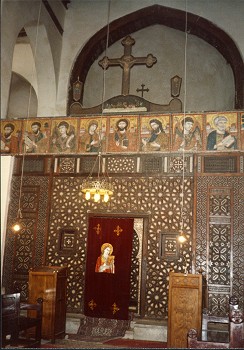
The term Coptic Period covers the time from the Roman Period down to the arrival of Islam in Egypt in around 641 of the Christian calendar. The Christian church in Egypt, called the Coptic church, was apparently founded by the apostle Mark in the 1st century AD. Despite vicious persecution under various Roman emperors, it developed very fast. Various ancient Egyptian elements were adopted into the liturgy and symbolism, for example, we find ankh-signs worked into Coptic illustrations, and the singing in the Coptic church, accompanied by sistra and cymbals, is very reminiscent of ancient Egyptian temple singing. There is even an echo of the ancient Egyptian language in the Coptic language used during the service. Coptic forms the last phase of development of the Egyptian language; as the spoken vernacular it replaced Late Egyptian, and co-existed alongside Demotic, which was mainly used for administrative, legal and commercial purposes. As early as the Saite Period, people had considered writing the ancient Egyptian language with Greek letters, which were much easier to use than the complicated hieroglyphic system, and in the Ptolemaic Period we can see increasing evidence that hieroglyphic words were being written phonetically. The earliest evidence for the developing habit of writing Egyptian words with Greek letters dates from the 2nd and even the 3rd century BC.
When the oldest written Coptic sources appear in the 2nd century AD, they are part of a development that had been going on for centuries.
Complete adoption of the Greek alphabet, supplemented by some Demotic letters for sounds for which Greek has no letter, must have occurred in a short space of time, partly spurred on by the need to translate the bible into the vernacular. The Coptic church, considered by church history to be one of the monophysite churches, still exists and is led by Pope Shenuda III. Its characteristic monasticism has been undergoing a revival lately.